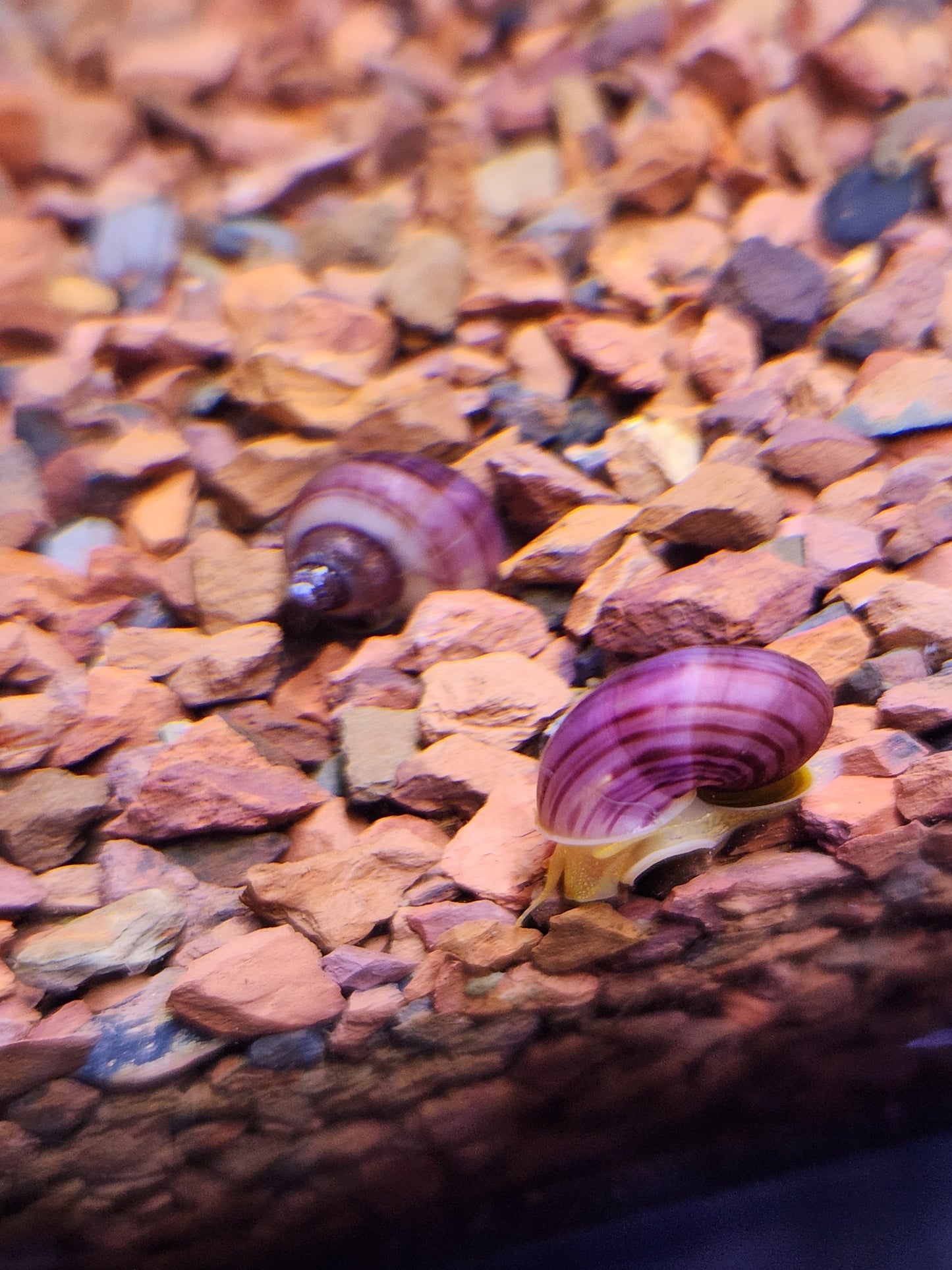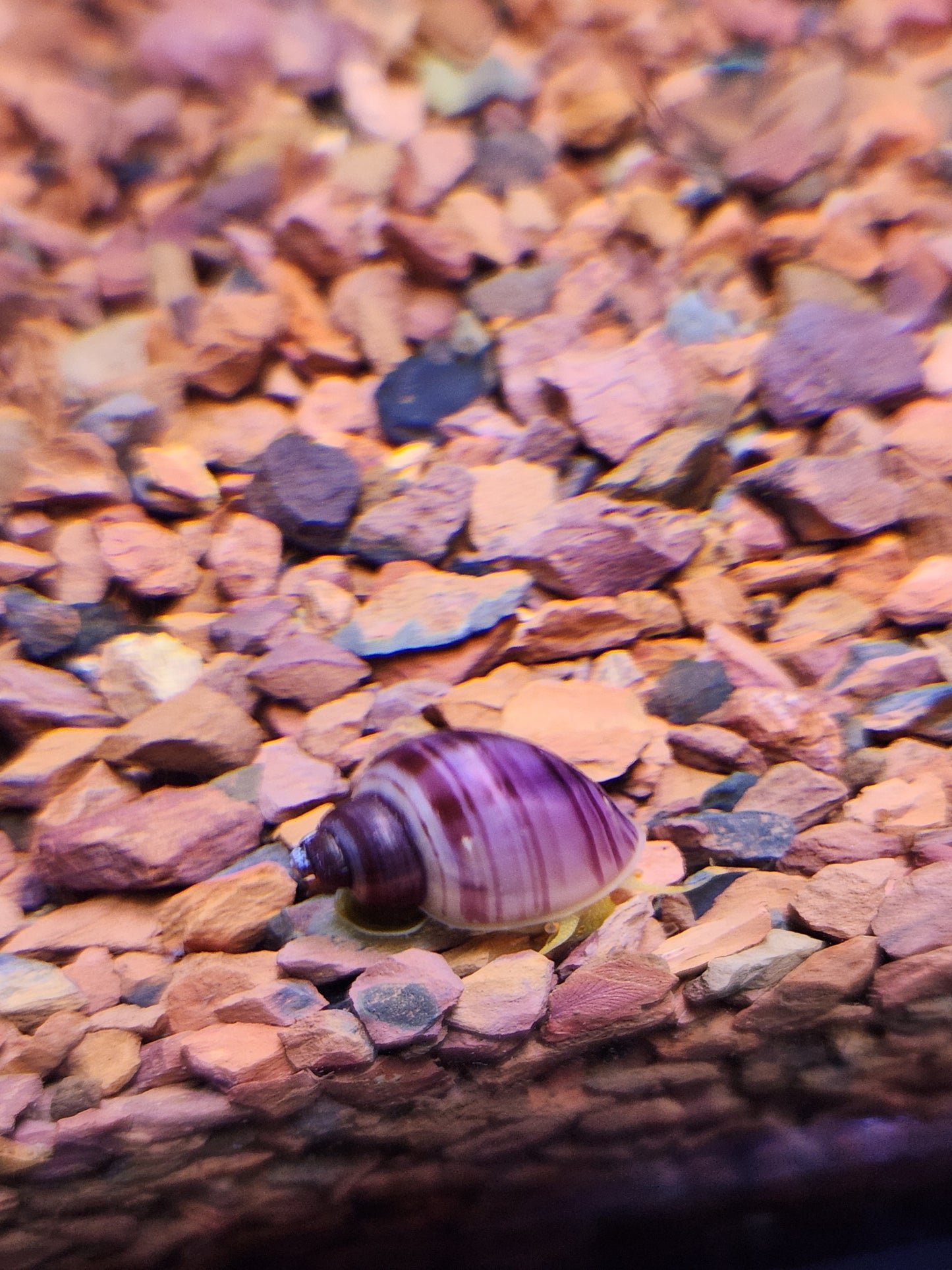Magenta Mystery Snail
Magenta Mystery Snail
Low stock: 1 left
Couldn't load pickup availability
The Magenta Mystery Snail (Pomacea bridgesii), also known as the Magenta Apple Snail, is a stunning variety of freshwater snail that is popular in aquariums due to its vibrant coloration and beneficial cleaning habits. Here's everything you need to know about this beautiful snail:
1. Appearance:
-
Color: The Magenta Mystery Snail is known for its bright magenta or purple-pink shell and body, which makes it stand out in the aquarium.
-
Shell: The snail has a smooth, round shell that can range in color from a soft pinkish hue to a deep magenta, sometimes with lighter or darker patterns, depending on the specific individual.
-
Size: They typically grow to around 2-3 inches (5-7 cm) in diameter. They have a relatively large shell compared to their body size.
2. Behavior:
-
Peaceful and gentle: Magenta Mystery Snails are non-aggressive and are known for being peaceful tank inhabitants. They are great additions to community aquariums.
-
Active: These snails are nocturnal to some extent, so they are most active at night, but you can often see them gliding along the tank during the day too, especially if there is food around.
-
Algae Grazers: They are known for being great algae eaters and will help clean up algae on tank walls, decorations, and plants. However, they don't typically eat brush algae or string algae.
-
Slow Movers: Mystery snails tend to move slowly across surfaces and substrates, leaving a shiny trail behind them.
3. Tank Requirements:
-
Water conditions: Magenta Mystery Snails prefer neutral to slightly alkaline water (pH between 7.0 and 8.5) and thrive in water temperatures between 68-82°F (20-28°C).
-
Tank size: They can be kept in aquariums of all sizes, but a 10-gallon tank or larger is ideal for keeping a few snails.
-
Filtration: A gentle filter is recommended since they do not like strong water currents. Ensure that the water quality remains high with regular water changes.
-
Substrate: They prefer a smooth substrate (such as gravel or sand) that is easy for them to move across. Avoid sharp-edged gravel, which can damage their soft bodies.
4. Diet:
-
Omnivorous: Magenta Mystery Snails are scavengers and will eat a variety of foods, including algae, decaying plant matter, and leftover fish food.
-
They are not harmful to live plants; however, they may occasionally nibble on soft plants, so it’s important to have a balance of algae and other food sources for them.
-
In addition to natural algae, you can supplement their diet with blanched vegetables like zucchini, spinach, and lettuce. They also enjoy snail pellets and algae wafers.
-
It's crucial to ensure they are getting enough calcium in their diet, as they need it to build and maintain their shells. Offering calcium-rich foods or adding calcium supplements to the tank can prevent shell deformities.
5. Reproduction:
-
Eggs: Female Magenta Mystery Snails can lay bright pink or orange eggs above the waterline on tank walls or decorations. These eggs are very visible and can be removed if you don’t want the snails to breed.
-
Sexual Reproduction: They lay eggs after mating, and once the eggs hatch, the baby snails will be fully formed and capable of surviving in the aquarium. They are relatively easy to care for and will grow into adult snails.
-
Control: If you don’t want the population to increase, you can remove the eggs before they hatch, or simply allow the snails to live in a tank without other snails.
6. Lifespan:
-
Mystery Snails generally live for about 1-2 years, though some can live up to 3 years with proper care.
7. Tankmates:
-
Magenta Mystery Snails are peaceful and make great tankmates for a variety of fish, shrimp, and other snails, as long as the other inhabitants are not predatory or overly aggressive.
-
Be cautious when keeping them with cichlids, betta fish, or other species that might try to eat or harass the snails.
-
They do well with community tank species like tetras, guppies, and peaceful catfish.
8. Health & Care:
-
Water quality: To keep the snails healthy, it is important to maintain excellent water quality by performing regular water changes and ensuring that the tank is adequately filtered.
-
Shell condition: If the shell becomes soft, deformed, or damaged, it could be due to a lack of calcium or poor water quality. Provide extra calcium through foods or supplements.
-
Signs of illness: If the snail appears sluggish, stops moving, or withdraws completely into its shell, it may be a sign of poor water conditions, disease, or a lack of food. Check the water parameters and make sure they are within the ideal range.
9. Additional Care Tips:
-
Breathing: While these snails are primarily aquatic, they breathe air, so they will need to surface periodically to gulp air. It’s important to have the water level in the tank low enough for them to reach the surface easily.
-
Escaping: Magenta Mystery Snails are known for their ability to climb tank walls and may sometimes try to escape the tank if the water level is too high. Make sure there is a tight-fitting lid on the tank to prevent this.
Snails may hibernate 3-5 days after arriving during shipping.


I ordered two and got three, cant beat that! Very healthy and lively little guys, and of course, customer service was great, thanks.

